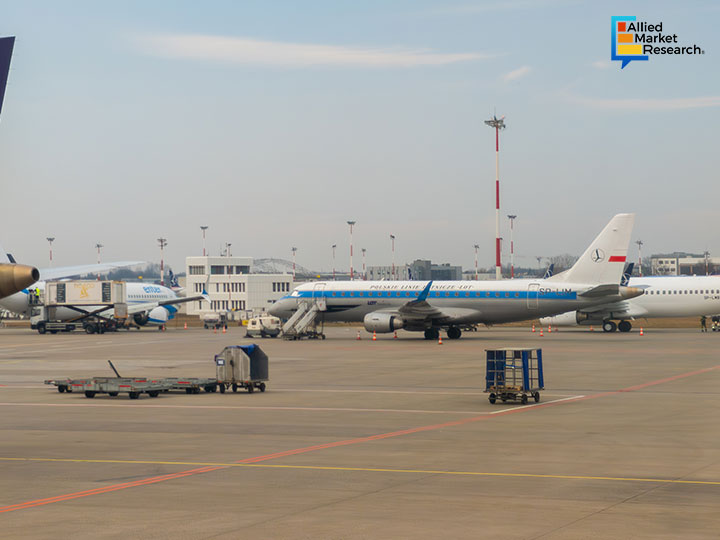Exploring the Role of Airport Stand Equipment in Ground Operations

8 Jul
2025
Highlights:
- Introduction
- Rise of Smart and Electric Equipment
- Importance of Reliable Ground Tools
Efficient airport operations don’t just rely on runways and terminals. A big part of smooth airline service happens where planes are parked. At this spot, a wide range of airport stand equipment is used to support the aircraft while it's on the ground. This equipment includes items like passenger boarding bridges, pre-conditioned air units, ground power units, aircraft towbars, and baggage belt loaders. All these tools are essential to ensure that an aircraft is serviced safely, quickly, and without any delays to the next flight.
Even though passengers rarely see this side of the airport, it is one of the busiest areas when a plane arrives or gets ready for departure. The performance and reliability of these systems can directly affect turnaround time, operational efficiency, and passenger satisfaction.
What Stand Equipment Really Does on the Ground
When an aircraft comes to a stop at the parking bay, a chain of activities begins within seconds. Ground crews move in with vehicles and equipment to manage tasks like towing the aircraft into position, unloading baggage, providing air conditioning or power supply, refueling, and preparing for boarding. Each task needs a specific type of stand equipment.
Passenger boarding bridges are probably the most visible. These structures connect the aircraft to the terminal building and ensure that people can board and exit the plane comfortably and safely, without stepping onto the tarmac. Some airports also use mobile stairs or ramps depending on the design of the terminal.
Then there are ground power units (GPUs). These are used to supply electricity to the aircraft when its engines are off. Without GPUs, the crew would need to run auxiliary power units on the aircraft, which consume jet fuel and increase emissions. Using ground power is not just more cost-effective but also more eco-friendly.
Pre-conditioned air units (PCAs), on the other hand, help maintain a comfortable temperature inside the aircraft while it's parked. These units replace the need to run onboard air systems and contribute to energy savings and emission control. For airports located in extreme climates, the efficiency of these units has become even more important.
Tugs and towbars are another essential part of the picture. Aircraft can’t move backward on their own, so they need strong towing vehicles for pushback. These tugs have to fit the size and weight of each plane and need to work well in any weather. According to Allied Market Research, the airport stand equipment industry contributed to $3.97 billion in 2020 and is expected to reach $7.22 billion by 2030, citing a CAGR of 6.4% during 2021-2030.
Recent Developments in Ground Handling Tools
In the last few years, there has been a growing focus on electric and hybrid stand equipment. With rising concerns around carbon emissions and the preference toward green airports, many manufacturers have started offering electric ground power units and electric tow tractors.
In May 2025, Avinor, the Norwegian airport operator, finished adding electric towing vehicles at Oslo Airport. This was part of its larger plan to cut down emissions across all its airports. Similarly, Hong Kong International Airport announced in early 2025 that it had upgraded its stand infrastructure to support fully electric GPUs and PCAs, making it easier for airlines to connect to cleaner ground support systems.
These changes are driven in part by new regulations. For example, the European Union has introduced stricter limits on carbon output at airports, which indirectly pressures ground handling teams to move away from diesel-powered systems.
Simultaneously, new systems can now track the condition of equipment, send alerts when maintenance is due, and even offer data insights that help optimize usage. This trend is especially important for larger hubs, where managing hundreds of ground equipment units manually is both time-consuming and error-prone.
Differences in Equipment by Airport Size and Type
Not all airports use the same type of stand equipment. Large international airports with wide-body aircraft will typically have advanced, high-capacity systems with permanent fixtures. Regional airports with smaller aircraft, on the other hand, often rely on mobile equipment that is easier to move and maintain.
Budget constraints and passenger volume also influence what kind of systems are installed. For example, some airports often prefer diesel units for their lower upfront cost, while others invest in electric solutions for their long-term environmental benefits. Similarly, airports in colder regions usually need additional ground equipment such as engine heaters or de-icing units, which are not as necessary in tropical climates.
Equipment standardization is also a concern. Airports that handle many types of aircraft from different airlines need tools that work with all models and systems. This makes planning, buying, and maintaining the equipment even more complicated.
Why Stand Equipment Needs to Stay Reliable
Ultimately, delays on the ground translate into financial losses for airlines, inconvenience for passengers, and increased pressure on airport operations. Malfunctioning GPUs or faulty boarding bridges can easily disrupt an entire flight schedule. This is why reliability, easy maintenance, and compatibility are key considerations when selecting airport stand equipment.
There’s also a growing need for training and upskilling ground crew members. With stand equipment getting more digital and automated, workers need to understand how both the machines and their software work. This makes equipment suppliers part of a much broader ecosystem, where they not only deliver machines but also support long-term operations through service, training, and upgrades.
Summing up
Airport stand equipment plays a significant role in smooth ground handling. Though not seen by passengers, it's highly important for airline and airport operations. From electric power units to smart tow tractors, these tools are evolving with new tech, rules, and a growing focus on sustainability. Airports are now prioritizing equipment that is safe, reliable, and eco-friendly.
Reach out to our team of experts to explore the changing dynamics of the airport stand equipment industry.

Koyel Ghosh
Author’s Bio- Koyel Ghosh is a blogger with a strong passion and enjoys writing in miscellaneous domains, as she believes it lets her explore a wide variety of niches. She has an innate interest in creativity and enjoys experimenting with different writing styles. A writer who never stops imagining, she has been serving the corporate industry for the last five years.
Cyber Defense in the Military: The Role of Advanced Cybersecurity Tools and Skilled Personnel
Avenue: Entire Library membership of Allied Market Research Reports at your disposal
- Avenue is an innovative subscription-based online report database.
- Avail an online access to the entire library of syndicated reports on more than 2,000 niche industries and company profiles on more than 12,000 firms across 11 domains.
- A cost-effective model tailored for entrepreneurs, investors, and students & researchers at universities.
- Request customizations, suggest new reports, and avail analyst support as per your requirements.
- Get an access to the library of reports at any time from any device and anywhere.
Related Post
-
How are Submarine Cables Transforming Global Connectivity with Enhanced User Experience?
-
Endoscopy Procedures: Transformations in Techniques and Applications
-
AI-Powered Video Analytics: How the Product Actually Works for enterprises
-
Painting Robots: Transforming Precision Coating and Creative Applications
-
Innovations in Pharmacovigilance Systems Advancing Patient Safety
-
Understanding Edge Security: Keeping Data Safe Near the Source
-
Exploring the Use and Advancements of 3D Laser Scanners in Professional Applications
-
Reinforcing Industrial Controls with Smarter Tools and Training








